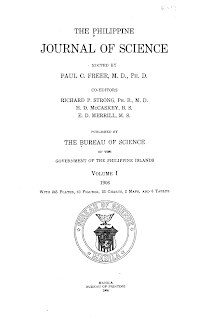In 1908-1909, the first systematic environmental surveys of the Philippines were made upon direct orders from President Teddy Roosevelt... American botanists inventoried our plant diversity. The records of their works are in the Philippine Journal of Science. Unfortunately you will have to travel to the USA to get access to a complete set of the tomes. I haven’t found a library in the Philippines with a complete set. Blame the Japanese for setting on fire the libraries in 1945.
The quote above, from "Beyond 'Earth Hour': Some new things I’ve learned," reminded me that I've been meaning to feature—again—The United States and its Territories: 1870-1925: The Age of Imperialism (USIT), which includes in its collection all the volumes of Philippine Journal of Science (PJS), from the first one ever published in 1906 to 1949.
I have previously dubbed USIT "the best and largest online collection of Filipiniana materials available for free," although I've also said that, "The site has some usability issues, but hey, if you need something and the library's closed or too far away, USIT is it." In the case of PJS, there will be no need "to travel to the USA," but you'll have to keep the following in mind when trying to locate particular articles:
1. A search on USIT for "philippine journal of science" as title will lead to a list that does not recognize the volume numbers as such. For instance, volume 1 is followed by volume 10, 11, 12, etc.; 2 by 20, 21, 22, etc.; 3 by 30, 31, 32, etc.
2. Some volumes contain all issues published that year, while others seem to be collections of articles that appeared in different sections of PJS for a particular year. This means that some links on the list will lead to webpages that include ALL the issues published in one year, while links to some volumes will be split into, for example, 11-A, 11-B, 11-C and 11-D. Note, however, that 12-B does not appear with 12-A, 12-C and 12-D, but at the end of the list. [Don't ask me why. It must have something to do with the metadata.]
3. Not all the links will lead to actual issues. In some cases, these go to supplements, and one in particular takes the reader to a separate index for the years 1916-1925.
4. The interface isn't the easiest to use, but make sure you explore the site's toolbar at the top. Changing "Format" allows users to view a PJS page as an image, as text or download it as a pdf file. "Page no." may be used to go directly to "Title Page" or "Table of Contents," which may in turn be used to jump to a specific page. This is also very helpful in the case of volumes with multiple issues, and hence, multiple title pages and tables of contents. And then, of course, "Page size" and "Search this text" are self-explanatory =)



